Landscaping your yard can feel like a huge project, but honestly, it doesn’t have to be scary.
You’ll spot ideas here that work for all kinds of budgets and tastes, so you can finally enjoy a yard that feels like home.
Maybe you want low-maintenance plants, or you’re dreaming of bold hardscaping and quirky accents. There’s something for every gardener here.
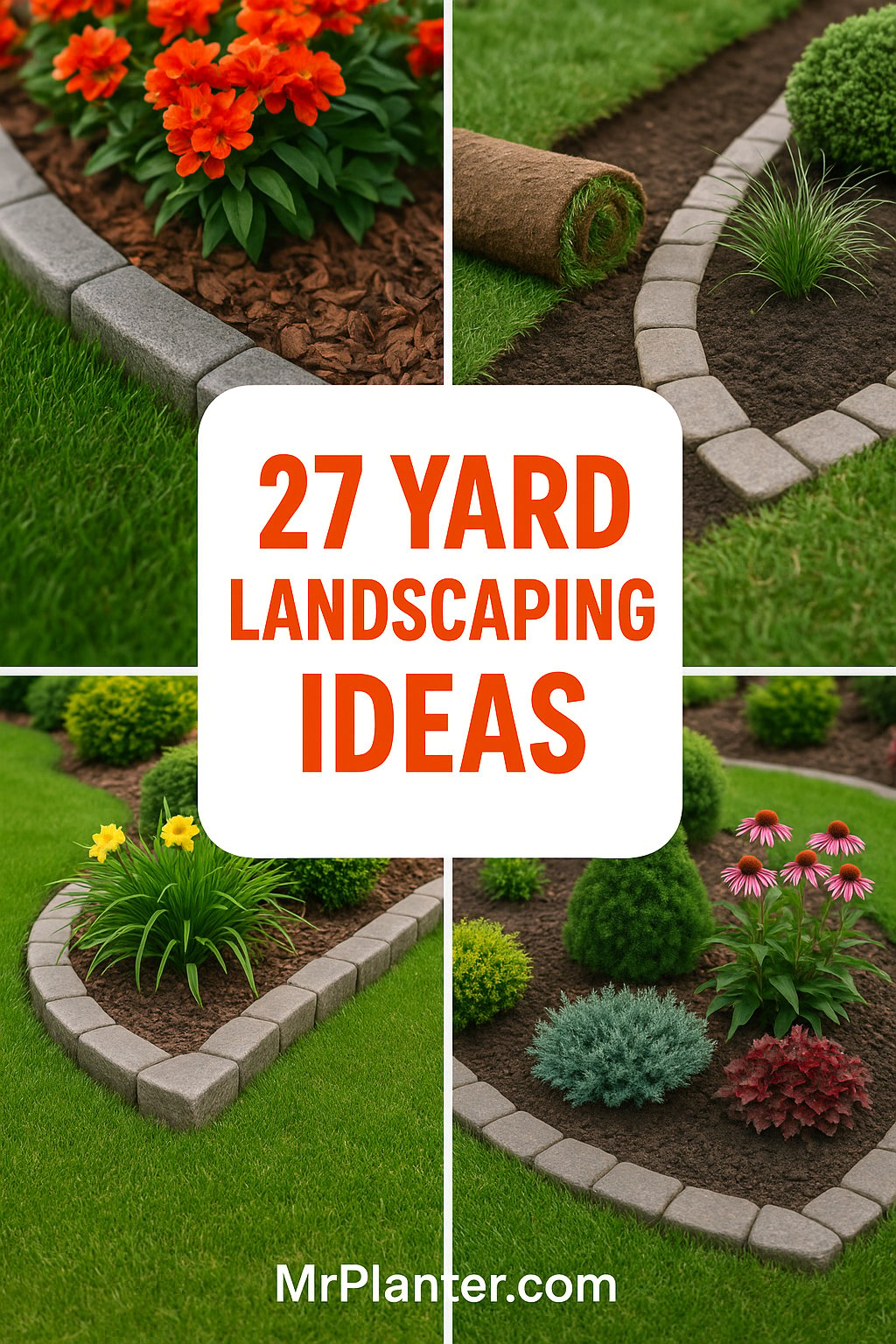
How to Assess Your Small Yard Before Starting Your Transformation
Don’t make the mistake of jumping straight into landscaping without really looking at your yard first. You’ll want to take a weekend afternoon to just hang out in your space and notice a few key things.
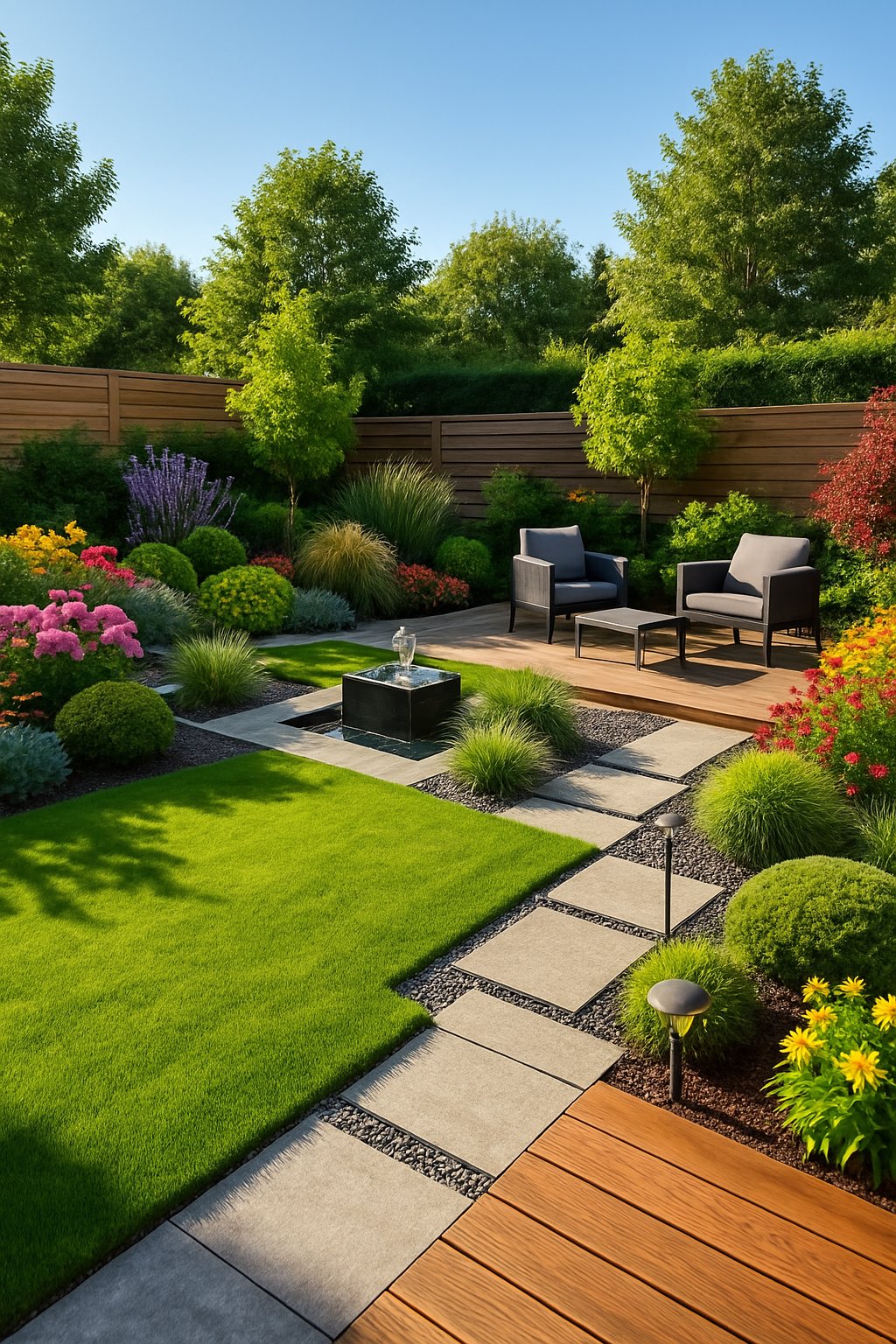
First, check out the sun patterns. You might be surprised when you realize your “sunny spot” only gets about 3 hours of direct light!
Walk around at different times of day and make mental notes (or actual notes if you’re organized). Your delicate plants will struggle if you place them in what becomes a sun trap by mid-summer.
Grab a handful of dirt while you’re at it. Is it sticky and clumpy? That’s clay, and it’ll retain too much moisture for certain plants.
Super gritty and doesn’t hold together? That’s sandy soil that’ll need extra water.
You might wonder why your flowers look droopy until you figure out your soil needs some adjustments.
After a rainstorm, check where water collects. If you ignore this step, you could end up with puddles by your patio every time it rains. Not ideal when you want to use your outdoor space!
Most importantly, be honest about how you’ll actually use the yard. Your dream might be an elaborate garden, but in reality?
You might need a spot for family activities and a small patio where you can enjoy your morning beverage in peace.
Your inspiration board might love that fancy water feature, but maybe what you really need is a low-maintenance space you can enjoy without weekend-long projects.
A little observation now saves you plenty of effort (and budget!) later. Your future self will thank you.
Now, let’s dive into the amazing yard landscaping ideas:
1. Create a cozy fire pit area with seating
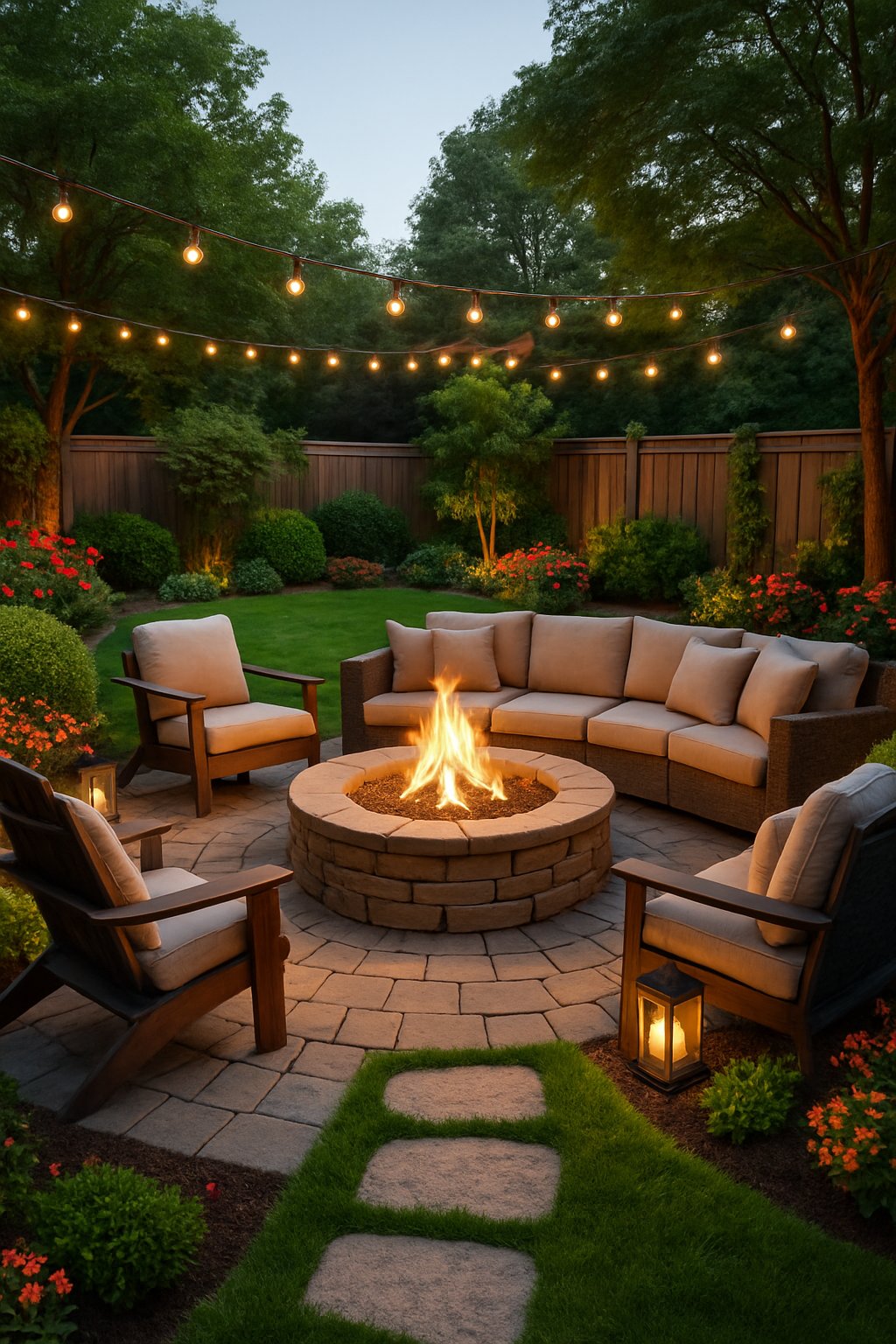
A fire pit brings warmth and a welcoming vibe to your yard. Toss some seating around it and suddenly you’ve got the perfect spot for unwinding or catching up with friends.
Benches, chairs, or even built-in stone seats all work. Cushioned chairs give you extra comfort, while wooden or stone benches bring in that rustic charm.
Arrange the seats in a circle or semi-circle so everyone gets a bit of the fire’s glow. Soft lighting or a few throw blankets make it feel even more inviting after dark.
Roast marshmallows, swap stories, or just soak up a quiet evening outside. That’s really what a fire pit area is all about.
Expert Tip from MrPlanter: “Go for weather-resistant cushions so your seating stays comfy all year. Keep the seats a safe distance from the flames, but close enough to enjoy the heat.”
2. Add a vibrant butterfly garden with milkweed and lavender
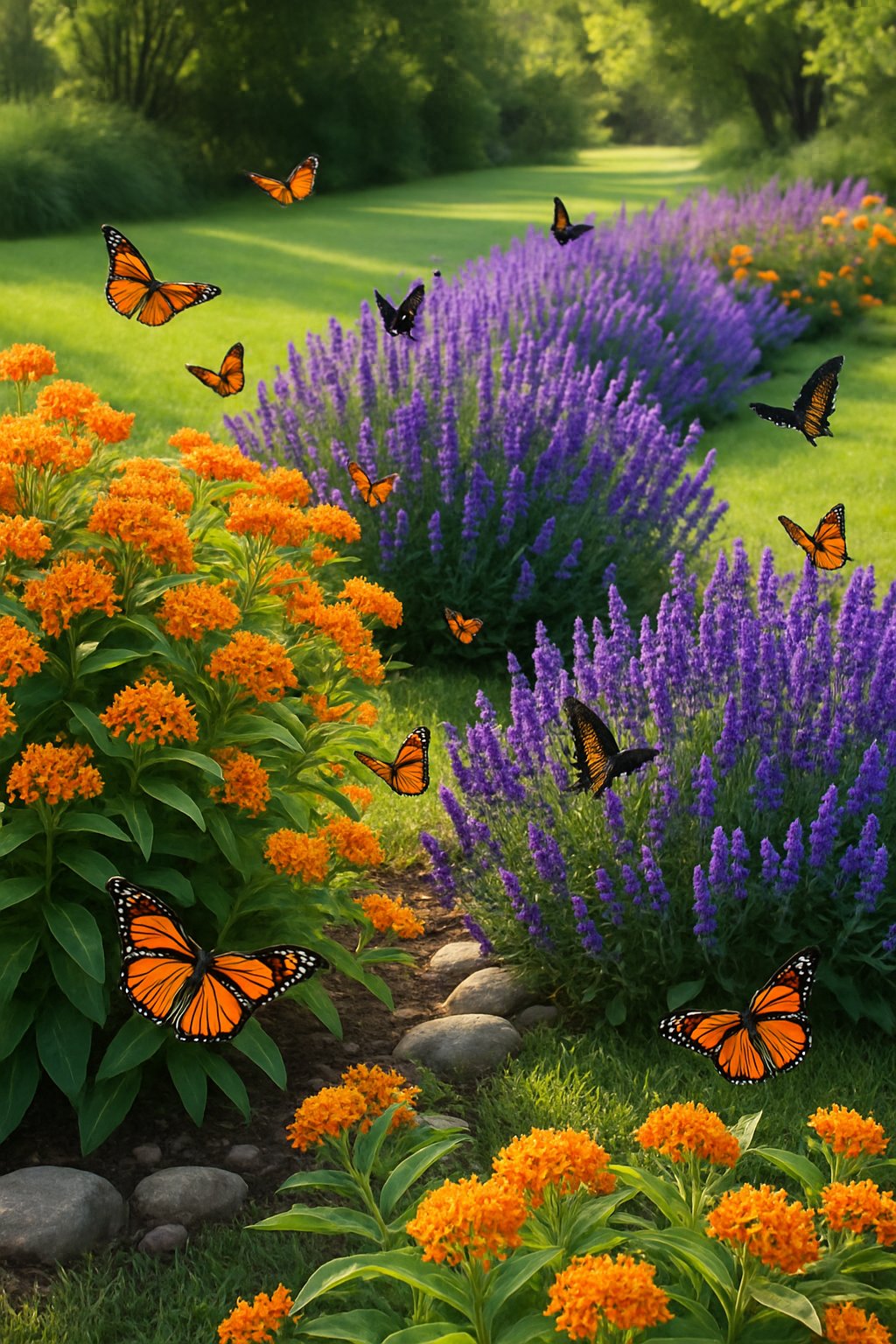
Butterflies can’t resist a yard full of milkweed and lavender. Milkweed draws in monarchs and feeds their caterpillars, while lavender brings color and a sweet scent.
Butterflies flock to lavender’s nectar, so planting both gives you a lively, colorful space. Try different milkweed varieties—swamp milkweed loves wet spots, while butterfly weed is super easy to care for.
Cluster the flowers so butterflies can find them easily. A butterfly garden also supports pollinators, which means the rest of your garden will thrive.
It’s such a simple way to bring more nature and beauty into your yard.
Expert Tip from MrPlanter: “Keep young milkweed watered so it can get established. Plant lavender where it’ll get lots of sun and well-drained soil for the best blooms.”
3. Build a raised herb garden for fresh cooking essentials
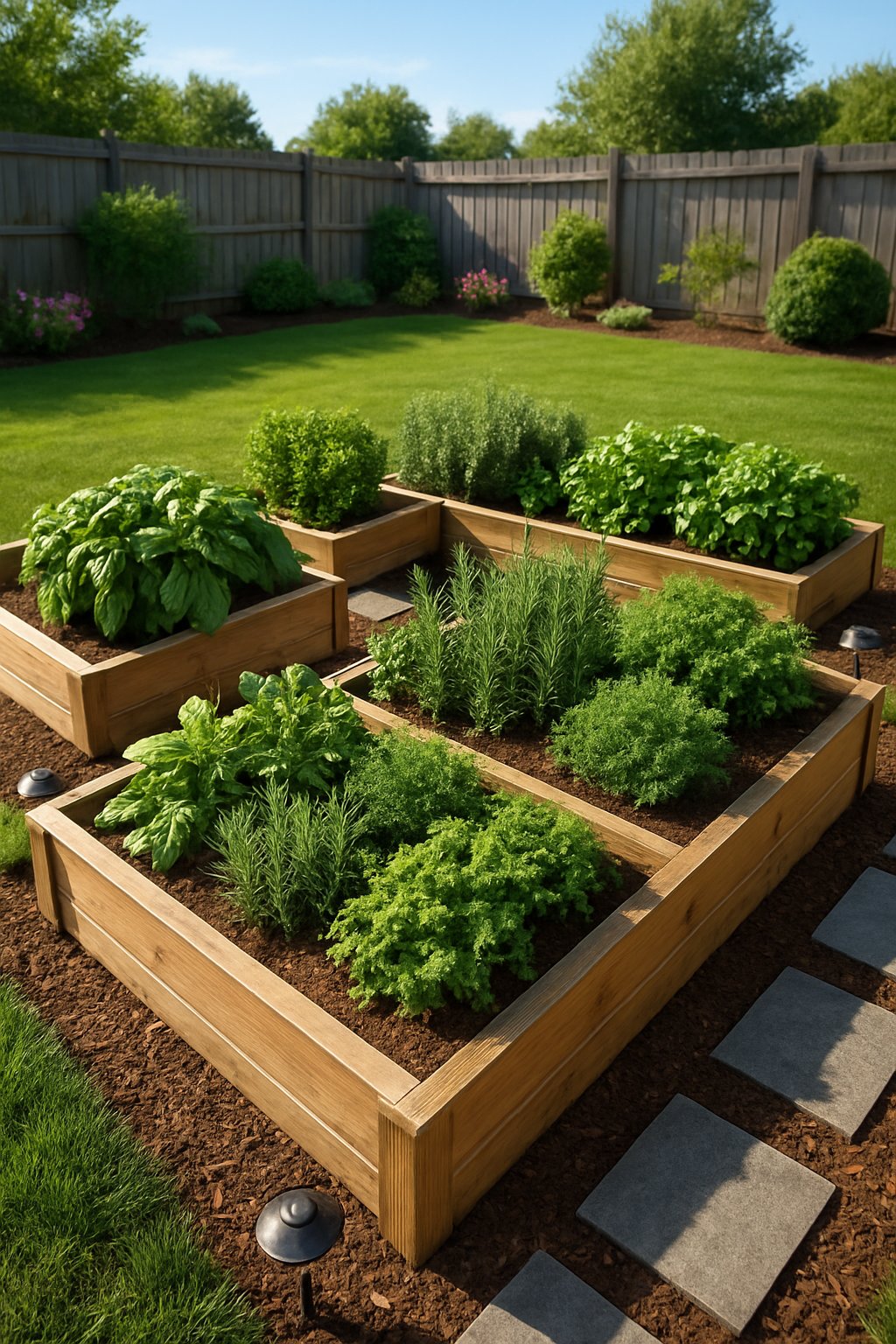
Set up a raised herb garden and keep fresh herbs just steps from your kitchen. Use wood or stone blocks to build a basic planter—nothing fancy required.
Pick a sunny spot that gets at least six hours of light every day. Good soil plus a bit of compost will give your herbs a strong start.
Plant kitchen favorites like basil, rosemary, and oregano. Raised beds drain better and make weed control way easier.
Water regularly but don’t drown your herbs. Snip leaves as you need them—this keeps plants healthy and boosts your meals.
Expert Tip from MrPlanter: “Build your raised bed at a height that’s easy to reach. Mix fast and slow-growing herbs so your garden always feels full of life.”
4. Install string lights around your patio for ambiance
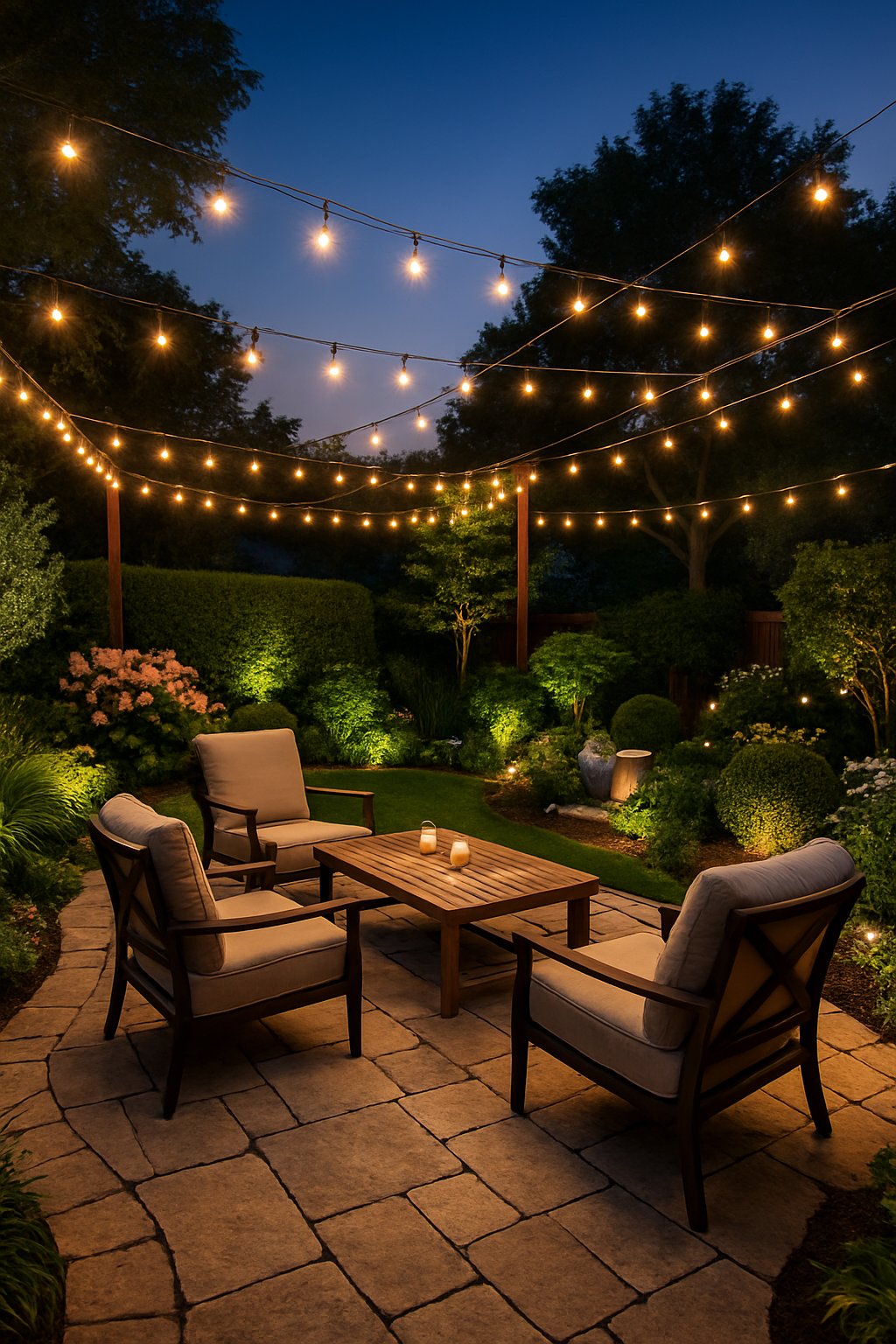
String lights can totally change the mood on your patio. They give off a soft, warm glow that makes the whole space feel cozier.
Hang them across the ceiling, wrap them around posts, or drape them along the railing—whatever looks good to you. A crisscross pattern overhead spreads the light nicely and adds a bit of style.
Pick LED string lights for durability and energy savings. Make sure they’re rated for outdoors so they last through rain and sun.
Surround the area with plant pots or hanging greenery to keep things feeling lush while the lights glow.
You don’t need any special tools—hooks or nails do the trick. Adjust as you go until it feels just right.
This little upgrade means you’ll actually want to hang out in your yard after dark.
Expert Tip from MrPlanter: “Use warm white LED bulbs for a mellow, relaxing glow. Double-check the connectors are waterproof so your lights survive the weather.”
5. Incorporate a vertical garden on a fence or wall
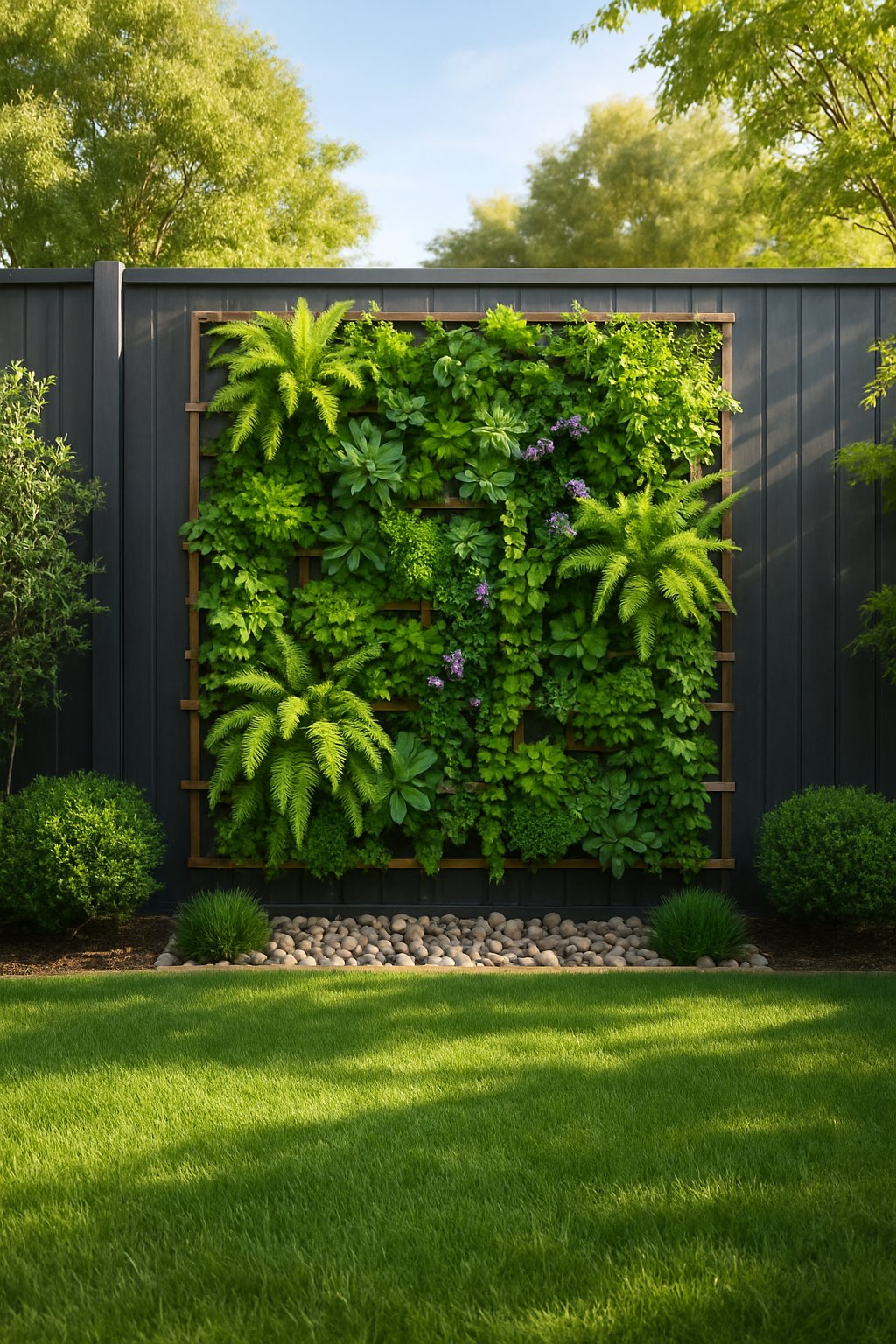
Turn a plain fence or wall into a living display with a vertical garden. Attach wire mesh or trellises for climbing plants like cucumbers or flowering vines—great for privacy and saving space.
Wall-mounted planters let you grow herbs, flowers, or even small veggies in a tidy, stacked way. This is perfect if you’re short on space but still want a vibrant garden.
Change up the plants with the seasons for a fresh look. A vertical garden can turn a boring wall into a real focal point.
Pick sturdy containers or felt pockets that drain well. Your plants will thank you for it.
Expert Tip from MrPlanter: “Start with easy herbs or succulents. Make sure your setup gets enough sunlight for whatever you plant.”
6. Use decorative rock gardens as a unique focal point
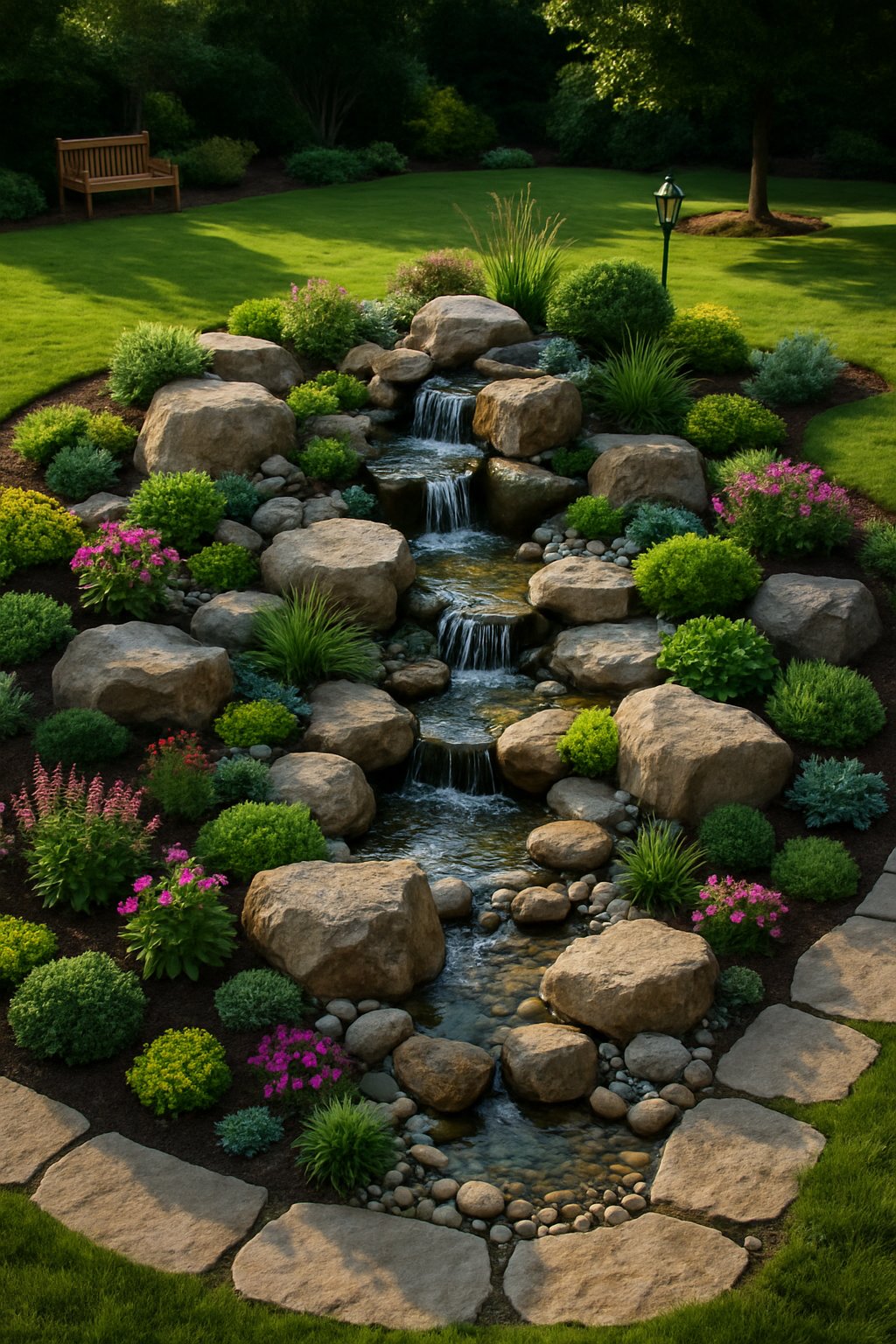
Give your yard a standout look with a decorative rock garden. Use rocks of different shapes and sizes to create eye-catching patterns or natural designs.
Mix smooth river stones with boulders for texture. Pop in some colorful perennials or shrubs between the rocks to keep things lively.
Rock gardens barely need any maintenance and look good all year. They work great as borders or as a centerpiece near your patio or walkway.
Add rock sculptures or cairns if you want a little artistic flair. These touches really give your yard some personality.
Expert Tip from MrPlanter: “Pick rocks that match your home’s vibe and color. Go with plants that thrive locally so your rock garden stays healthy without much fuss.”
7. Plant a mix of native trees for shade and privacy
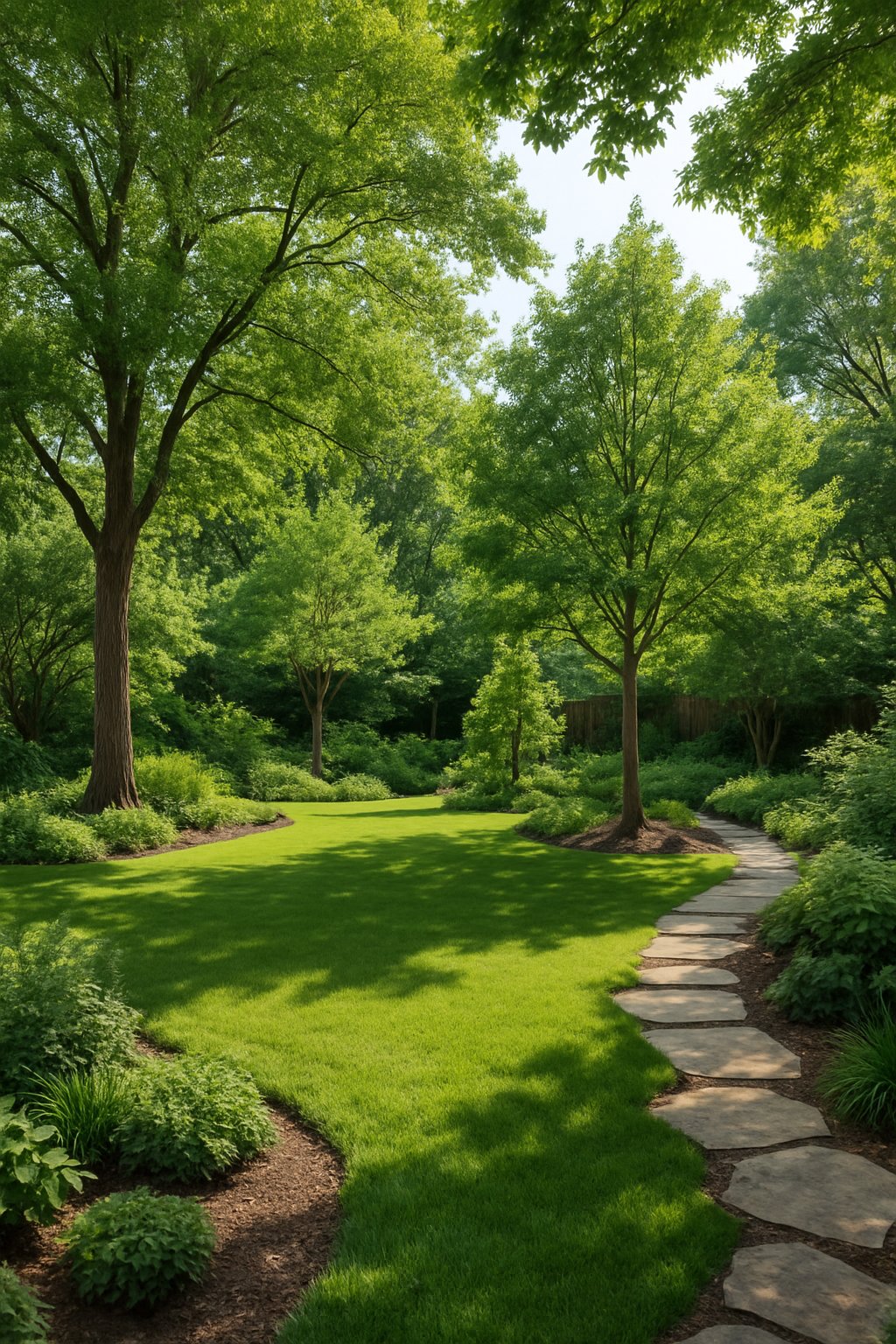
Native trees like oaks, maples, and dogwoods bring much-needed shade and privacy to your yard. Since they’re adapted to your local soil and weather, they need less water and maintenance.
Mixing up species creates a fuller, more natural-looking screen. Local wildlife will thank you—these trees offer food and shelter for birds and other critters.
Plant taller trees to block out neighbors or busy streets. Fill in with smaller trees for a layered, lush effect.
Native trees also help your soil and prevent erosion. They blend easily with other local plants for a balanced, healthy landscape.
Expert Tip from MrPlanter: “Space your trees so they have room to grow. Choose varieties that flower at different times for year-round interest.”
8. Design a small koi pond with aquatic plants
Bring a peaceful vibe to your yard with a small koi pond. Pick a spot that gets some sun, but not all day long—koi like a little shade.
Line the pond with a heavy-duty liner and install a filtration system to keep the water clear. Place rocks around the edge for a natural look.
Drop in aquatic plants like water lilies or lotus. They look great and help keep the pond healthy by adding oxygen and shade.
Koi fish come in so many colors and patterns—choose your favorites. Don’t overcrowd the pond, though; the fish need space.
Add a small waterfall or fountain to keep the water moving and fresh. That’ll help prevent algae, too.
Expert Tip from MrPlanter: “Use local aquatic plants for easier care and better pond health. Position plants so koi get some shade and algae stays under control.”
9. Set up a hammock corner for ultimate relaxation
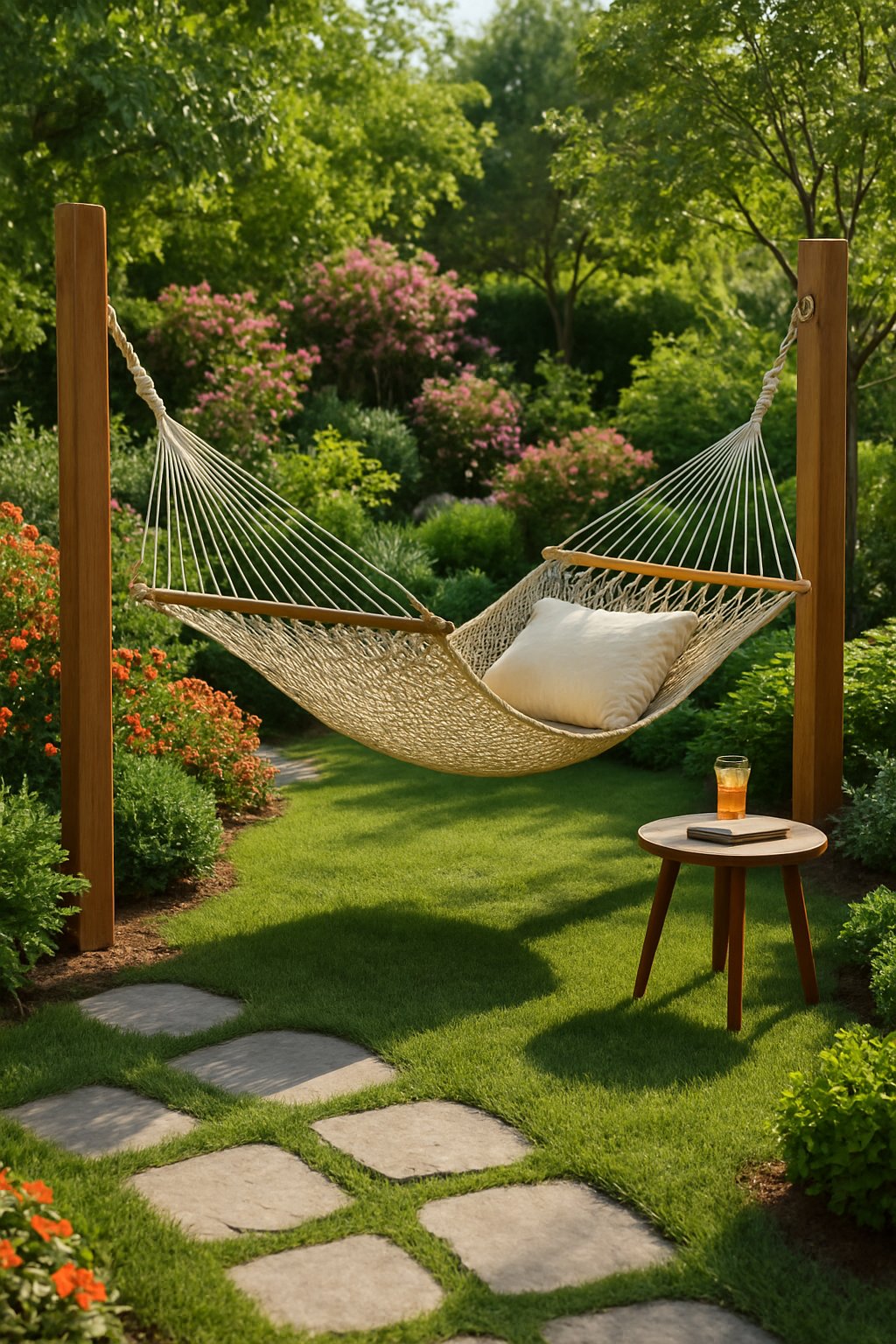
Set up a hammock corner in your backyard and you’ll have a quiet spot to kick back after a long day. Pick a shady area, or throw up a pergola if the sun’s relentless—trust me, you’ll thank yourself on those blazing afternoons.
Hang the hammock between two sturdy trees if you’ve got them, or grab a freestanding frame. If you want to amp up privacy and coziness, drape some light curtains or cluster leafy plants around your nook.
Soft outdoor lighting, like solar lanterns or string lights, can really set a chill mood once the sun dips. It keeps your little retreat inviting even after dark.
Expert Tip from MrPlanter: “Set your hammock where you catch the breeze for natural cooling. A small side table makes life easier—stash your drink and book right there.”
10. Create a dry creek bed to manage drainage creatively
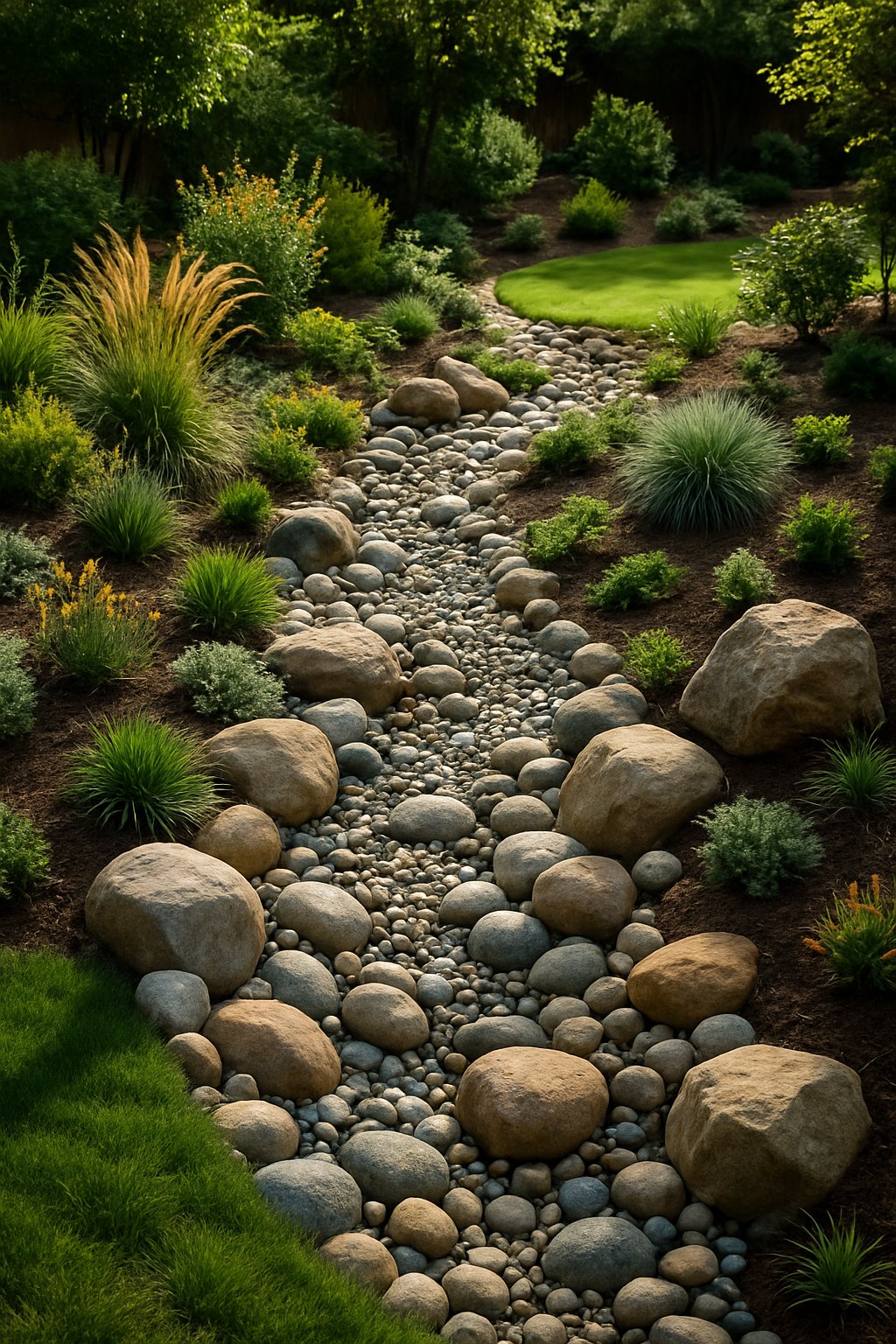
Dry creek beds solve drainage headaches and add a natural vibe to your landscape. First, spot a low area where rainwater likes to run wild. Sketch your creek’s shape before you break out the shovel.
Dig a shallow channel—6 to 12 inches usually does it. Lay down landscape fabric to block weeds and keep your rocks from sinking into the dirt. Scatter smooth river stones and gravel along the trench for that authentic creek look.
Edge the bed with native shrubs or ornamental grasses to soften the lines. Toss in a couple of boulders or even a log, and you’ll steer water and add some drama at the same time.
Expert Tip from MrPlanter: “Watch where water pools during a storm and let that guide your creek’s path. Native plants around the bed save water and blend right in.”
11. Add colorful flower beds with marigolds and daisies
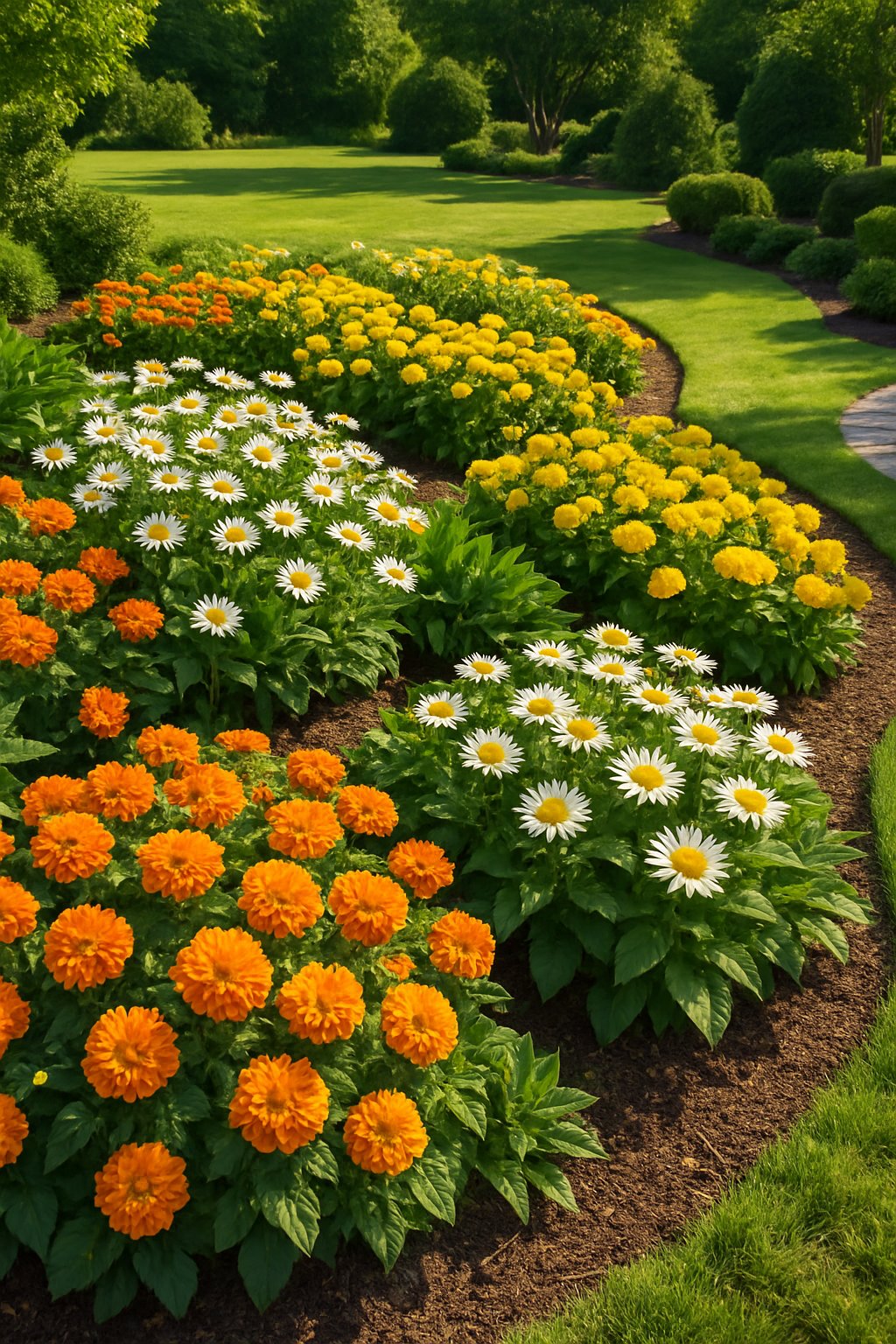
Planting marigolds and daisies in your flower beds instantly wakes up your yard with pops of color. Marigolds bring those bold orange and yellow hues, while daisies give you classic white petals and sunny yellow centers.
If you want low-maintenance, both of these flowers deliver. Marigolds naturally repel pests, so they double as garden bodyguards. Daisies pull in pollinators like bees, which boosts the rest of your blooms.
Mix them up in rows or clusters for a laid-back, cheerful effect. They work great as border plants or smack-dab in the middle for a bit of height.
Pick a spot that gets plenty of sun—these guys crave it for healthy growth.
Expert Tip from MrPlanter: “Pack marigolds close to choke out weeds. Pair daisies with taller plants for a layered, natural-looking bed.”
12. Build a wooden pergola with climbing vines

A wooden pergola brings structure and a bit of character to your yard. You get a cozy outdoor space for relaxing or hosting friends.
Train climbing vines to sprawl across the pergola. They’ll give you natural shade and a lush, leafy canopy that shifts with the seasons.
Stick with sturdy lumber like cedar or redwood for a long-lasting build. Double-check local codes before you start—permits can be a pain if you skip this step.
Pick vines that fit your climate—wisteria, clematis, or ivy all work well on pergolas. These climbers not only look great but settle in fast.
String up some lights or dangle a few hanging baskets to make the space extra inviting at night.
Expert Tip from MrPlanter: “Plant vines at the base of each post and gently guide them up. That way, you’ll get even coverage and a living roof in no time.”
13. Install a stone or brick pathway through the yard
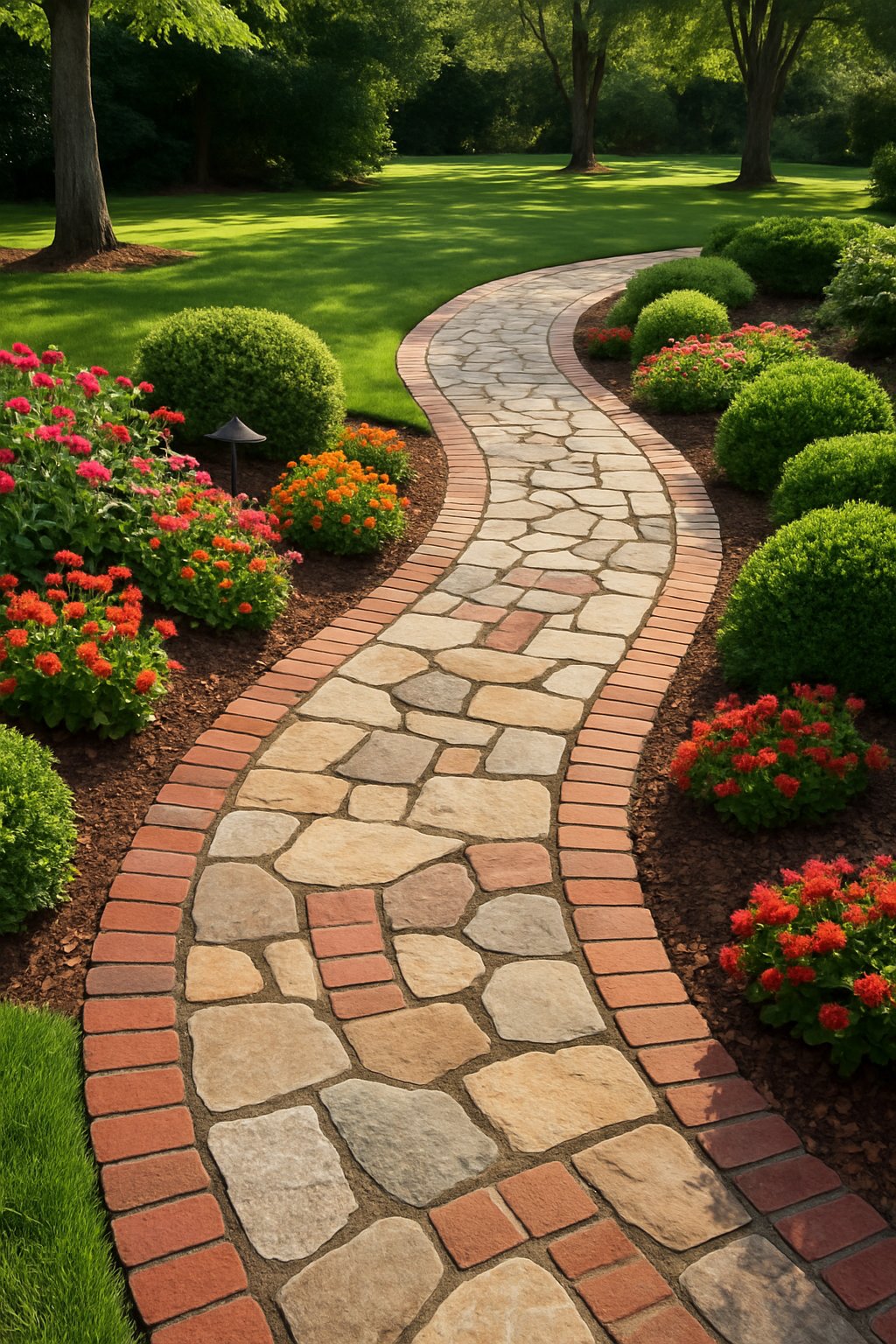
Stone or brick pathways give your garden structure and curb appeal. They show guests exactly where to walk and set a clear route through the beds. Choose materials like flagstone, pavers, or classic brick to match your style.
Paths can snake through curves or go straight, depending on your layout. Aim for a width of 3 to 4 feet for comfort, but you can squeeze it down for tight spaces.
Laying the stones or bricks takes elbow grease, but it’s doable for DIYers. Level out the soil and toss down a layer of sand or gravel to keep things stable.
Edge the path with plants or tuck in some low-voltage lights for safety and a bit of nighttime magic. Match materials to your home’s look for a seamless flow.
Expert Tip from MrPlanter: “Use edging to hold the path together over time. Pick stones or bricks that can handle your local freeze-thaw cycles for a path that lasts.”
14. Add a bird bath to attract local wildlife
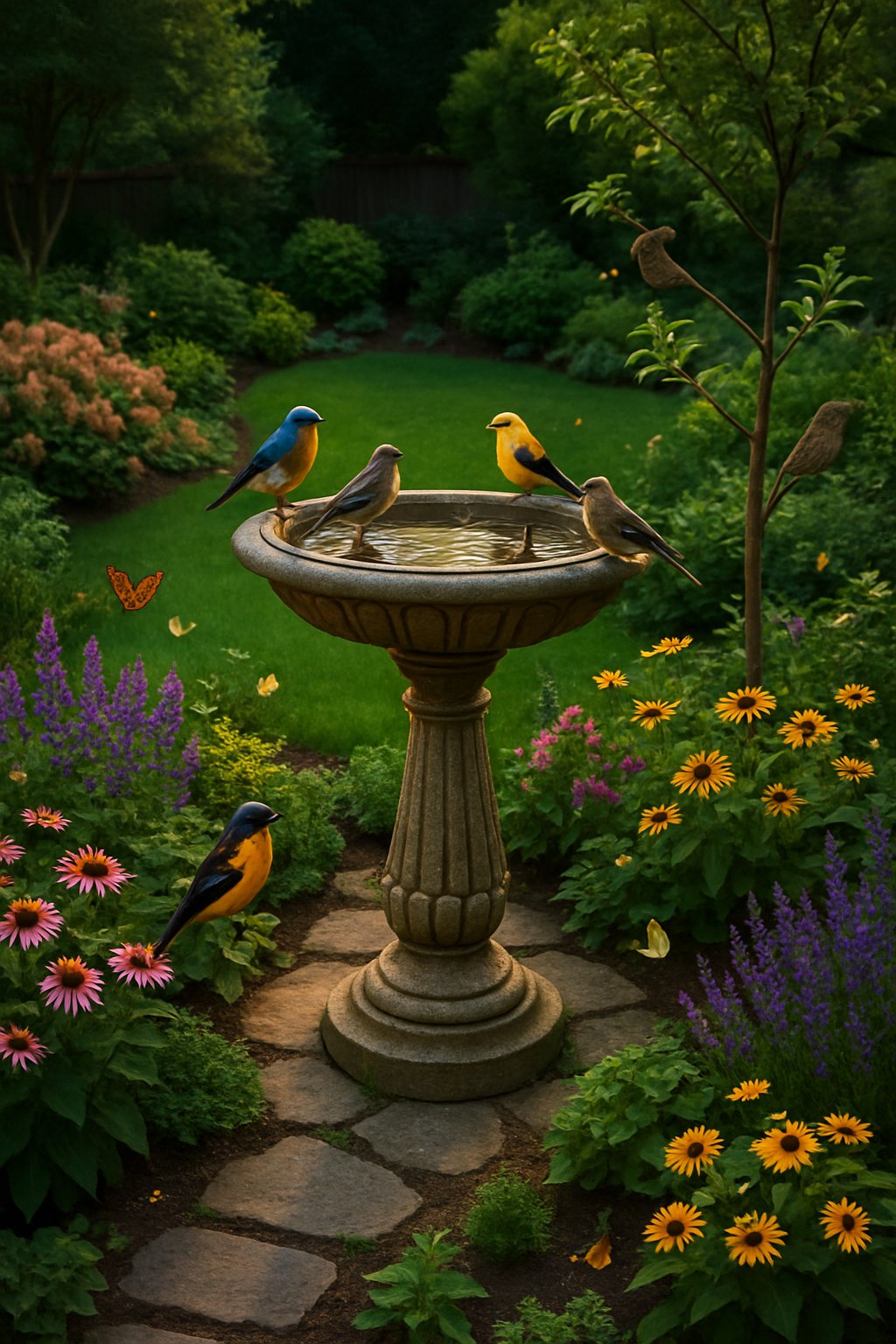
Set out a bird bath and you’ll spot more feathered friends in your yard in no time. Birds need fresh water, especially during summer heat or dry spells. A bird bath can turn your landscape into a mini wildlife haven.
Pick a style that fits your space—go classic with a pedestal, or try a compact version that hangs from a tree or hooks onto a fence. Make sure you can clean and refill it without hassle.
Surround the bird bath with a mix of flowers and shrubs. Taller plants in the middle, shorter ones around the edge—this setup gives birds some cover and makes the spot feel natural.
Keep water shallow—just 1 or 2 inches is plenty, with a gentle slope. Change the water regularly to keep mosquitoes and algae at bay.
Expert Tip from MrPlanter: “Set the bird bath near a window so you can watch the action. In winter, try a solar heater to stop the water from freezing up.”
15. Create a kids’ play zone with natural elements
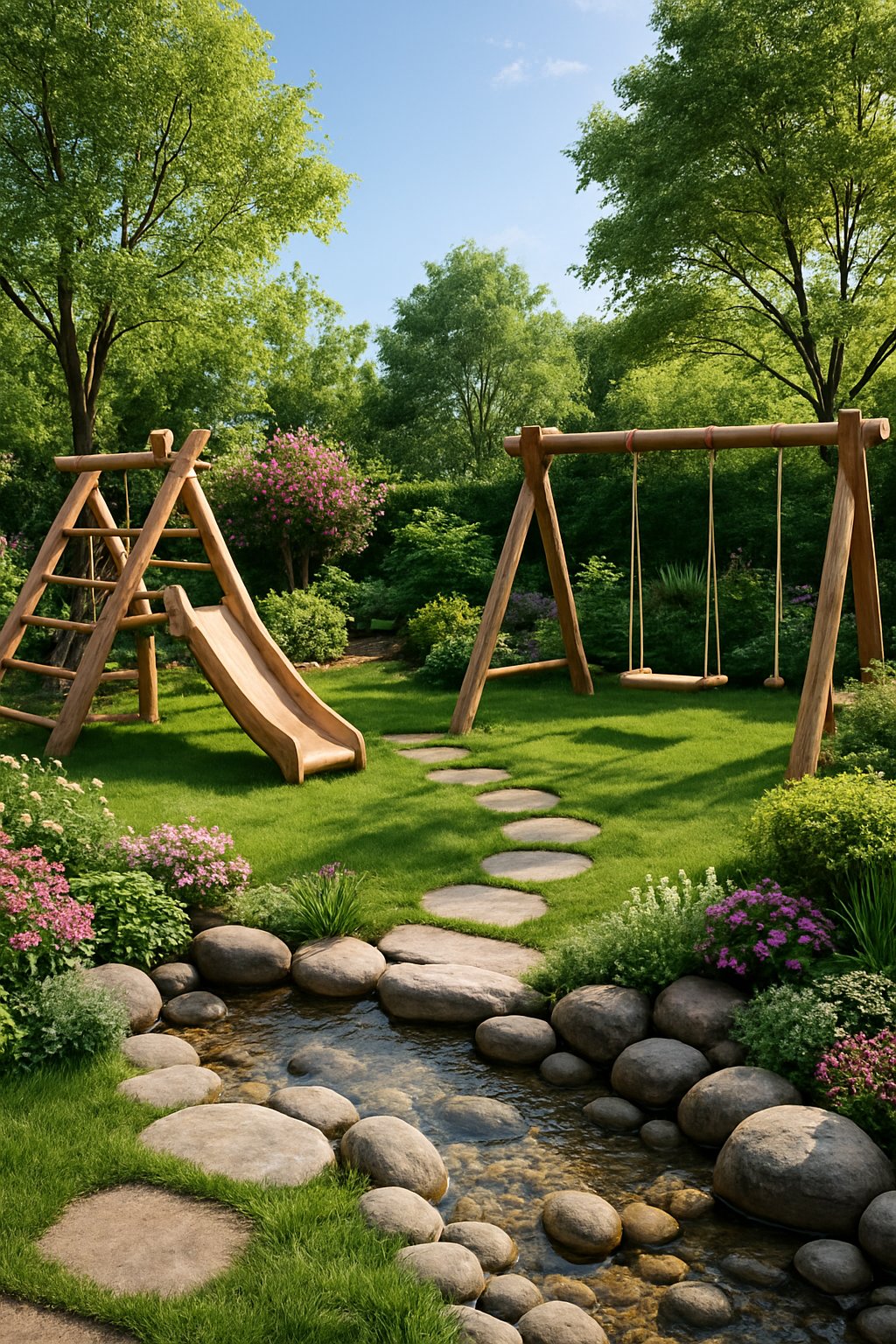
Transform part of your yard into a nature-inspired play zone for kids. Use logs, boulders, and native plants to create a space that feels like a wild little adventure. These features invite kids to explore and get creative outdoors.
Scatter loose materials like sticks, pinecones, or leaves for open-ended play. Kids love rearranging things, and it’s great for their problem-solving skills. Plant a few flowers, shrubs, or even a tiny garden nearby to add color and a touch of magic.
Consider adding a small pond or a bug hotel to spark curiosity about critters. Toss in textured surfaces—think bark mulch, smooth stones, or sand—for a sensory boost.
Keep the area tidy and free from sharp debris to make it safe. Place a bench or two close by so adults can relax and keep an eye out.
Expert Tip from MrPlanter: “Upcycle old materials for play features. It’s eco-friendly and the different textures keep kids interested.”
16. Use ornamental grasses for texture and movement
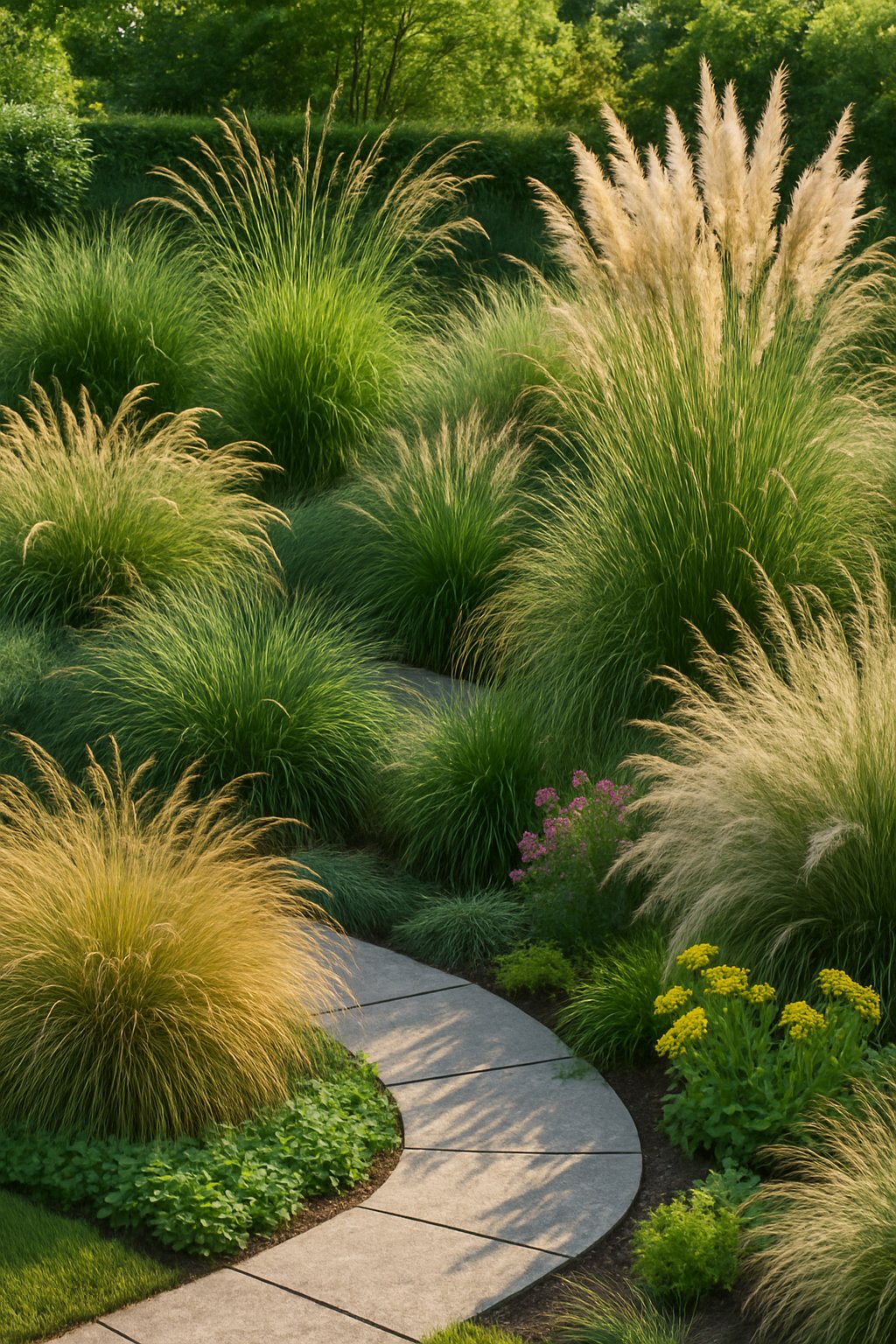
Ornamental grasses bring a soft texture that stands out in any garden bed. They contrast nicely with perennials and evergreens, adding a wild touch that’s hard to fake.
These grasses sway in the breeze and give your landscape movement. Tall varieties like fountain grass or miscanthus add height and drama.
Use them as privacy screens or plant them in clusters for a lush, full look. They tie planting beds together and make everything feel more natural.
Mix up different species for interest all year long. Most ornamental grasses need very little fuss once they’re established, so they’re perfect for low-maintenance landscapes.
Pick types that fit your local soil and climate. Birds and small wildlife will flock to them, too.
Expert Tip from MrPlanter: “Plant ornamental grasses along walkways to enjoy their movement up close. Layer a few heights for a natural, tiered effect.”
17. Set up a cozy outdoor reading nook with cushions
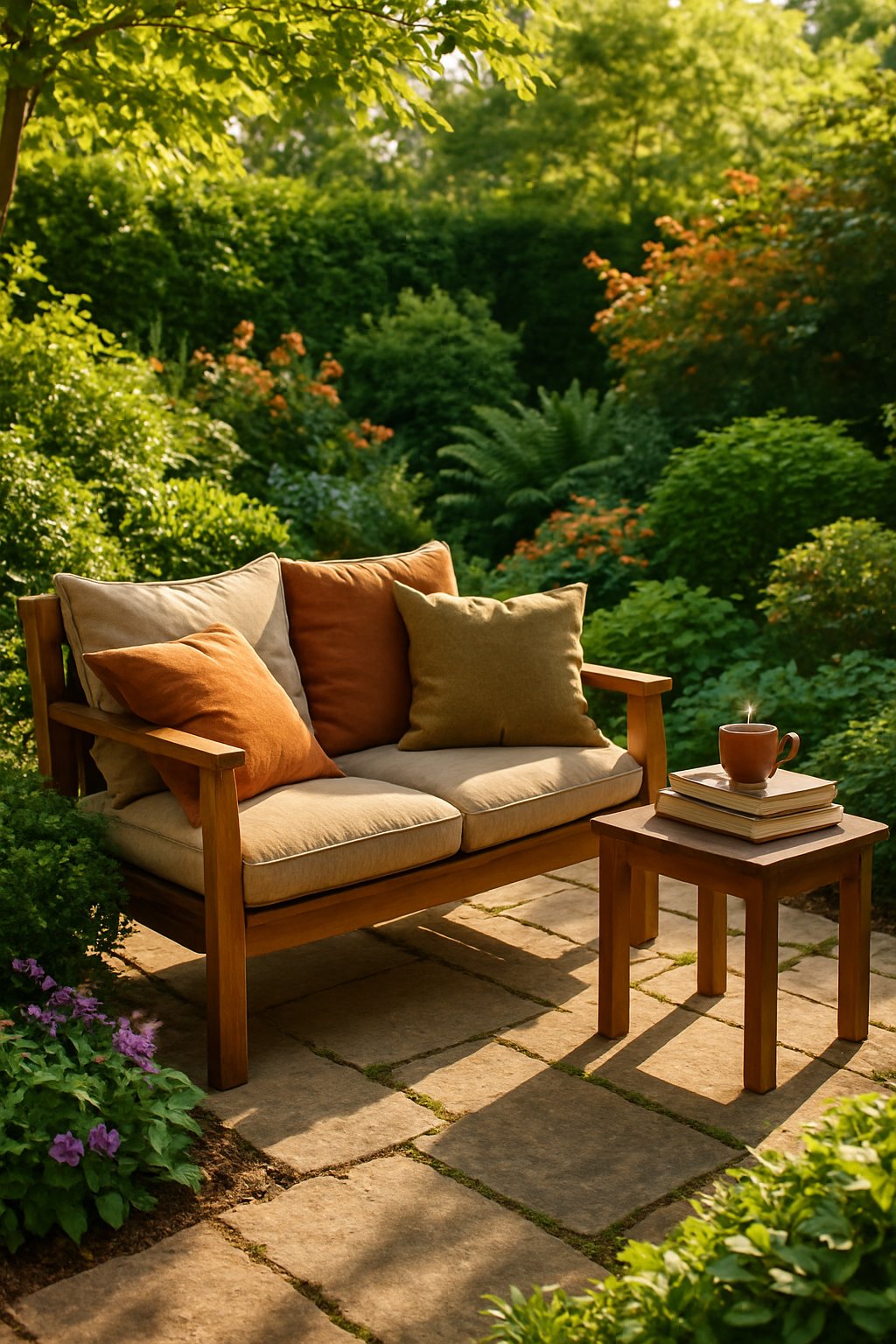
Find a peaceful corner in your yard where you actually want to sit. Drop in a comfy bench or chair. Cushions are a must—they really make the space welcoming.
Stack cushions for extra comfort and play with colors to match your vibe. Use outdoor fabrics that can handle the weather. Arrange them so you can lean back and get lost in a book.
Think about shade—trees, a patio umbrella, or even a pergola can help keep things cool. Add a side table for your mug or stack of novels so you don’t have to get up.
String up fairy lights or lanterns for evening reading sessions. Keep a throw blanket handy for chilly nights.
Expert Tip from MrPlanter: “Go for cushions with removable, washable covers. It’s a lifesaver for keeping your nook fresh and ready anytime.”
18. Add container gardens for herbs and flowers

Container gardens bring bursts of color and fresh herbs right into your landscape. Grab some pots, planters, or even old wheelbarrows—pretty much anything you can repurpose—and you’ll have unique nooks for your favorite plants.
Basil, thyme, and mint thrive in containers, and honestly, who doesn’t love snipping herbs for a quick dinner? These guys are easy to care for and always handy in the kitchen. Violas and petunias? They’ll throw a splash of color and really liven up small spaces.
Mix things up—try tall plants in the middle and let trailing varieties spill over the edges. You’ll get a layered, lush effect with hardly any effort.
Pick containers that match your space. Even a tiny patio or balcony can handle a few container gardens, so don’t let a small yard stop you.
Move your containers around to chase the sun or tuck them into the shade when it gets too hot. That flexibility really helps your plants thrive all year.
Keep the potting mix high quality and water regularly—just don’t drown them. Feed your plants every couple of weeks so they stay healthy and keep blooming.
Expert Tip from MrPlanter: “Group containers with similar sunlight needs together for easier care. Use lightweight containers if you plan to move them often.”
19. Build a multi-level deck for entertaining
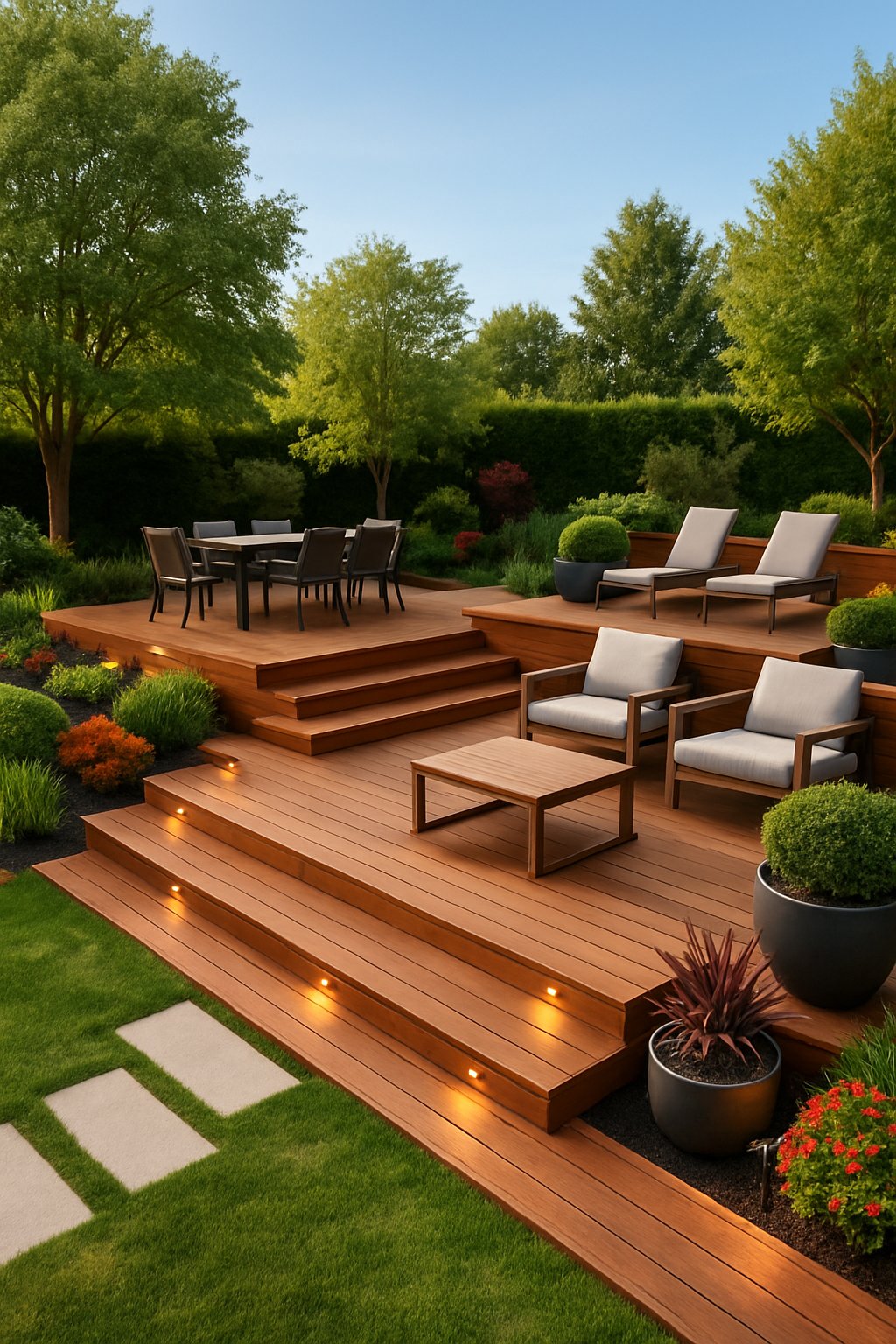
If you want to amp up both style and space, a multi-level deck makes a big difference. You can dedicate each level—one for grilling, another for dining, maybe a cozy spot just for relaxing.
Gardeners often use different deck levels to break up the yard without adding fences or walls. The design can follow the natural slope, or just show off a view. Wood or composite decking keeps things sturdy and low-maintenance.
Try adding built-in planters or some outdoor lighting to make the space feel welcoming, day or night. Steps and railings tie the levels together, and you end up with more usable space without losing green areas.
Expert Tip from MrPlanter: “Plan your multi-level deck layout to match how you’ll use the space. Focus on easy access between levels and enough seating for guests.”
20. Incorporate solar-powered garden lights
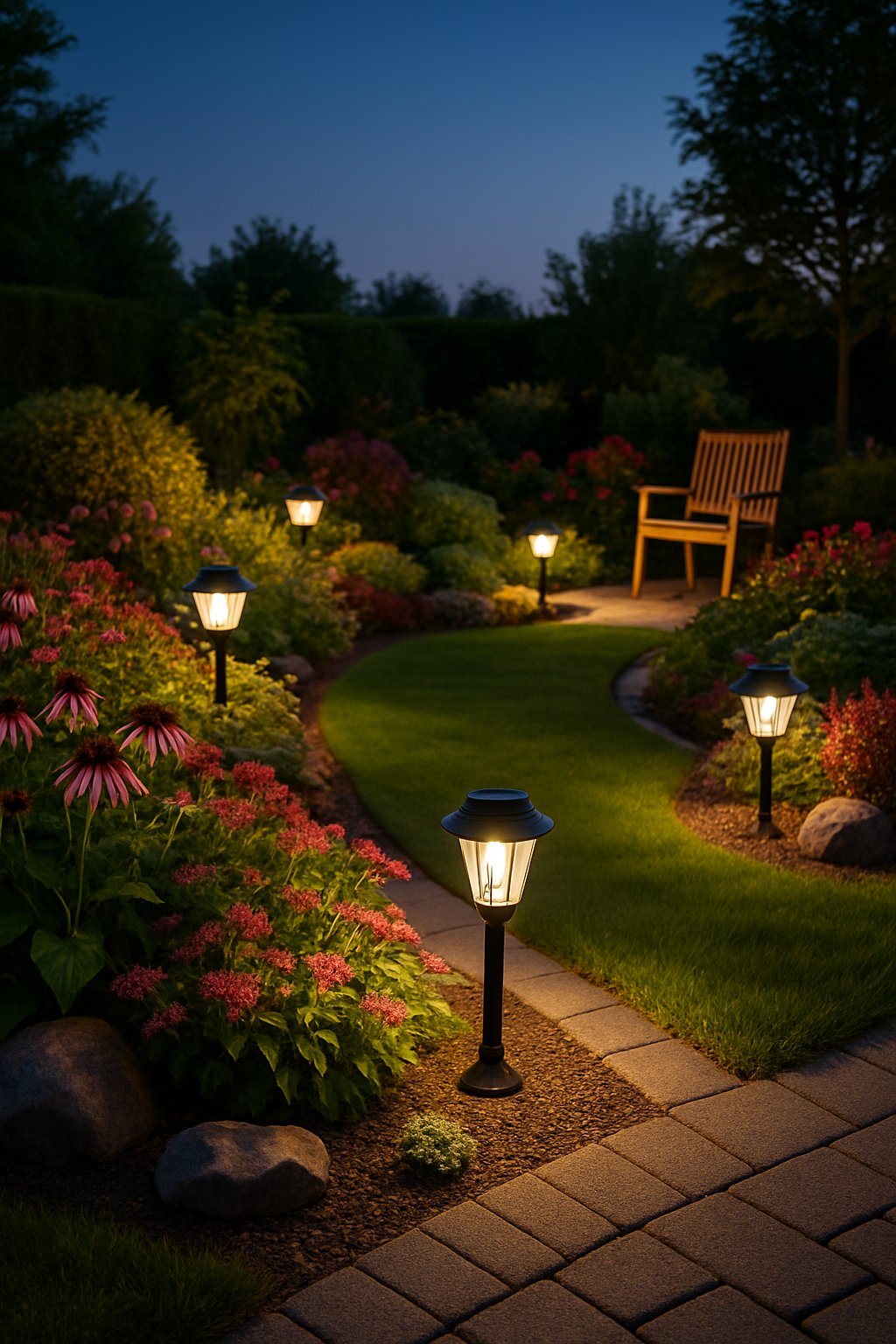
Solar-powered garden lights brighten up any yard and won’t bump up your electric bill. These handy fixtures soak up sunlight all day and switch on by themselves at dusk.
Use them to edge your paths, spotlight your favorite trees, or make your flower beds glow. You’ll find solar lights in all shapes and styles, from classic lanterns to quirky garden stakes.
They’re eco-friendly and barely need any attention. Just make sure they’re placed where they’ll get plenty of sun for a full charge.
Solar lights also make your garden safer by lighting up dark steps or corners. The warm glow feels inviting, especially if you like to hang out outside after sunset.
Pick sturdy, weather-resistant models so they last through the seasons.
Expert Tip from MrPlanter: “Place solar lights at different heights for a layered lighting effect. Always clean the panels regularly to keep them working at their best.”
21. Plant a mix of evergreens and flowering shrubs

Mixing evergreens with flowering shrubs keeps your garden lively all year. Evergreens hold their color through winter, and when spring hits, flowering shrubs explode with blooms. It’s a classic combo for year-round interest.
Plant taller evergreens in the back and tuck flowering shrubs in front for depth. Add groundcovers at the base to soften the edges and keep weeds down.
Try staggering your plants, not just lining them up. It gives a relaxed, natural vibe. Shrubs with different leaf textures or colors make the garden pop.
Swap out a few shrubs every couple of years if you want to shake things up. Choose species with staggered bloom times so you always have something flowering.
Expert Tip from MrPlanter: “Choose evergreens with various shades of green and blue to add subtle color changes. Pair with flowering shrubs that bloom at different times for constant interest in your yard.”
22. Create a succulent garden for low maintenance

Succulent gardens look fantastic and don’t demand much attention. These plants store water in their leaves, so you can skip a few waterings without worry. Mix up shapes and colors—there’s a surprising variety out there.
Pick a sunny spot and use well-draining soil. Raised beds or rock gardens suit succulents perfectly. You can even edge a path with them or fill awkward corners.
If you want to save time but still want a lush vibe, succulents are the way to go. They also thrive in containers or creative setups like pallets or wreaths.
Expert Tip from MrPlanter: “Use sandy soil for better drainage, so your succulents don’t get soggy. Group plants with similar water needs together to keep care simple.”
23. Install a water feature like a small fountain
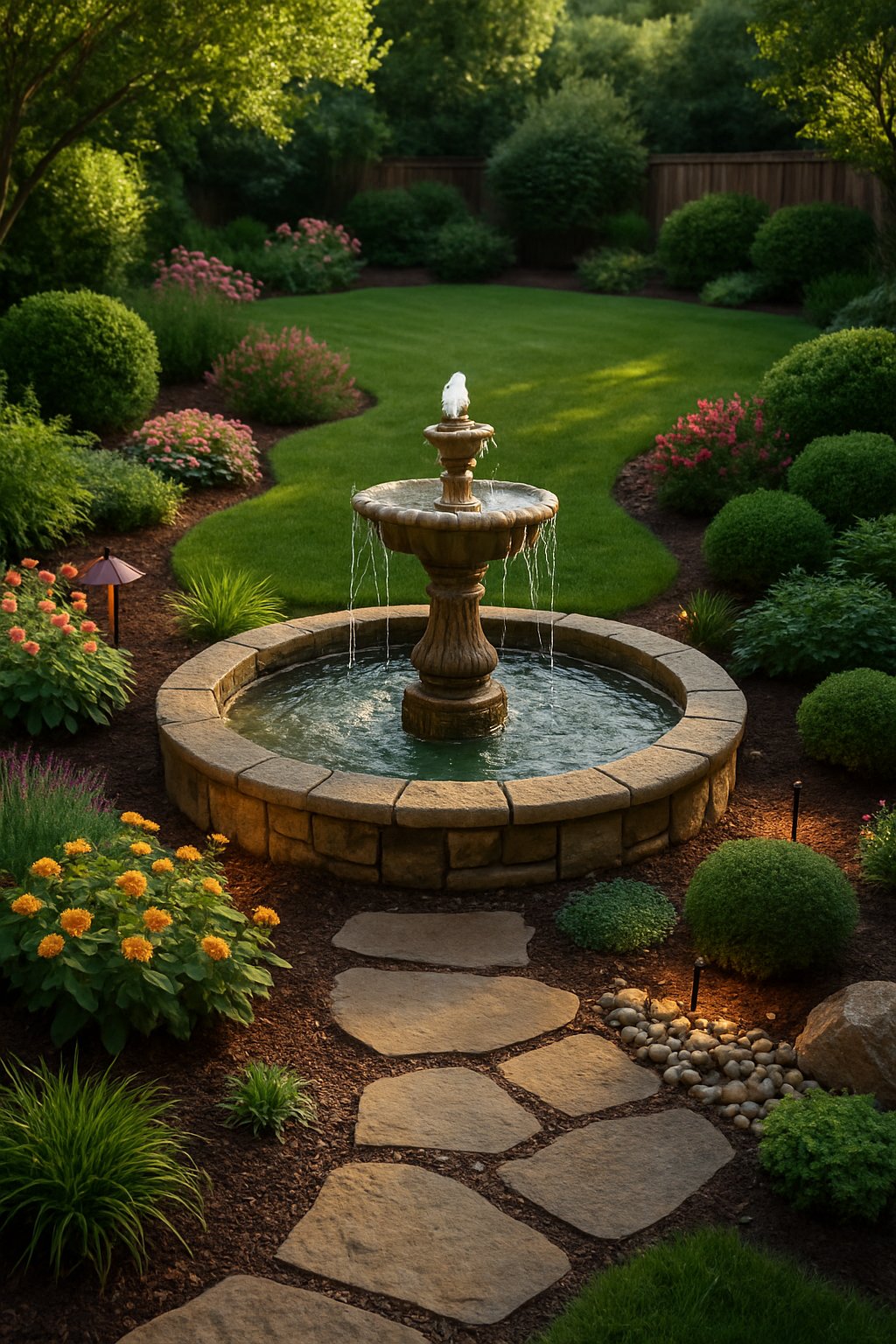
Add a small fountain if you want soothing sounds and a cool focal point. Even tight spaces can fit a petite water feature.
Go for a tabletop fountain or build one with natural stone for a tucked-in, organic look. Choosing materials like wood, stone, or metal helps the fountain blend with your garden’s style.
Water features draw birds and pollinators, bringing more life to your yard. Try floating a few aquatic plants or tucking in some colorful stones for extra texture.
Make sure the pump runs quietly and you can get to it for cleaning. Place the fountain where you’ll hear it but avoid splashing on walkways.
Expert Tip from MrPlanter: “Place your fountain near seating areas so you can relax to the sound of water. Keep some extra water on hand to refill during dry spells.”
24. Add a vegetable patch for fresh produce
Start a vegetable patch and you’ll have fresh produce right outside your door. It saves cash and you get to pick what you want, when you want it. Begin with just a few plants or try a square foot garden for neat rows and easy care.
Find a sunny spot—most veggies need at least 6-8 hours of sunlight. Set up raised beds or use metal edging for clear borders. This keeps things tidy and makes weeding way easier.
Grow what your family actually eats. Rotate your crops every season to keep the soil healthy. Water regularly, but don’t let the soil get soggy—veggies like it just moist enough.
Expert Tip from MrPlanter: “Plant herbs alongside your vegetables to save space and enhance flavor. Keep your soil rich with compost to grow strong, healthy plants.”
25. Use reclaimed wood for DIY garden furniture
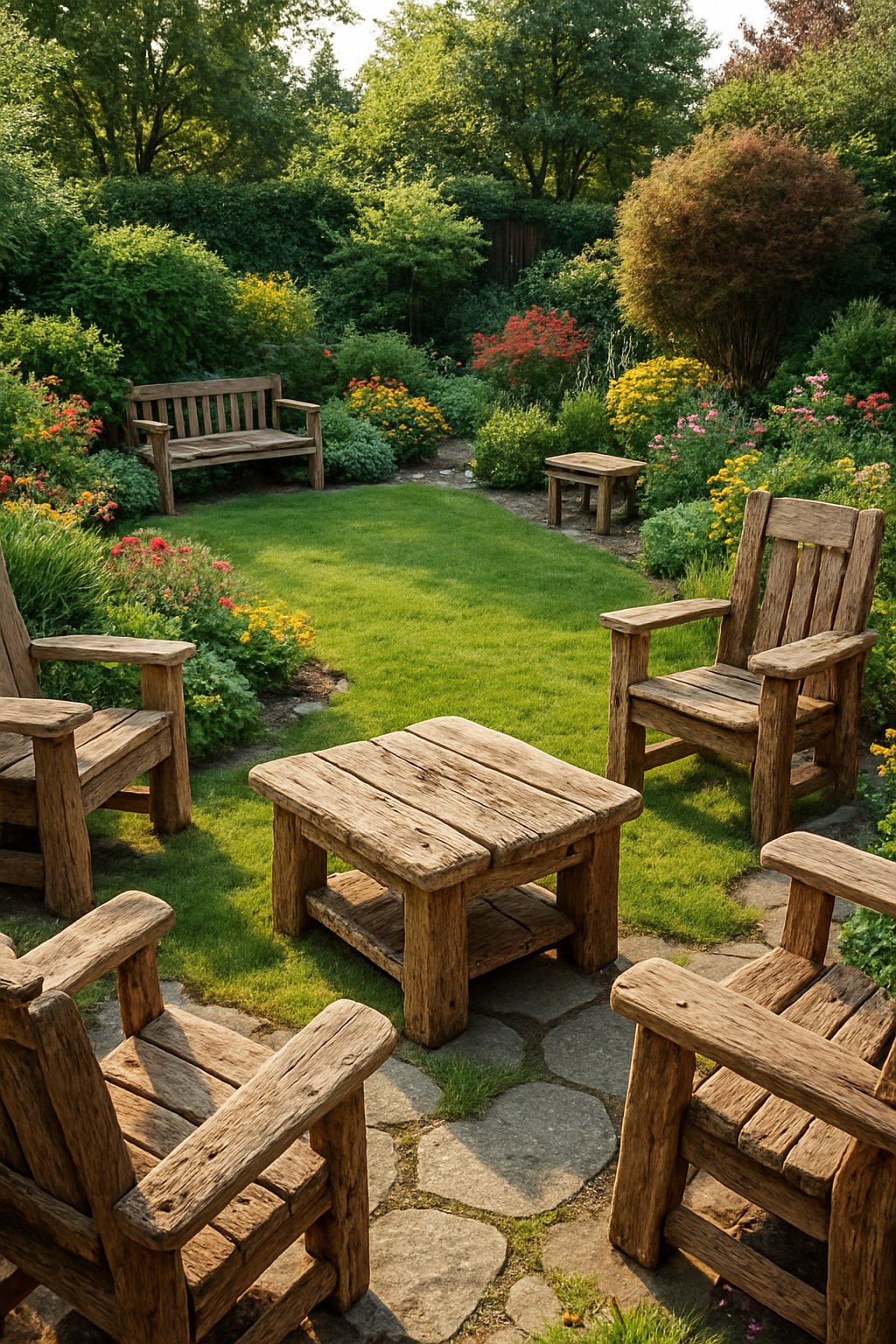
Reclaimed wood gives your garden furniture loads of charm and saves you money. Build a bench, a table, or a few chairs—each piece will have its own rustic personality.
Old wood comes with unique grain patterns and weathered colors you just can’t fake. That character makes your furniture stand out from store-bought sets.
Always use dry, treated wood for outdoor projects. Hardwoods like oak or cedar hold up best against the elements.
Add comfy cushions made for outdoor use. You can buy them or sew your own with weather-resistant fabric—just don’t forget this step if you actually want to sit outside for a while.
Upcycling old wood cuts down on waste, so it’s a win for the environment too.
Expert Tip from MrPlanter: “Always seal reclaimed wood before use to protect it from moisture. This keeps your furniture looking good and lasting longer.”
26. Design a zen garden with sand and stones
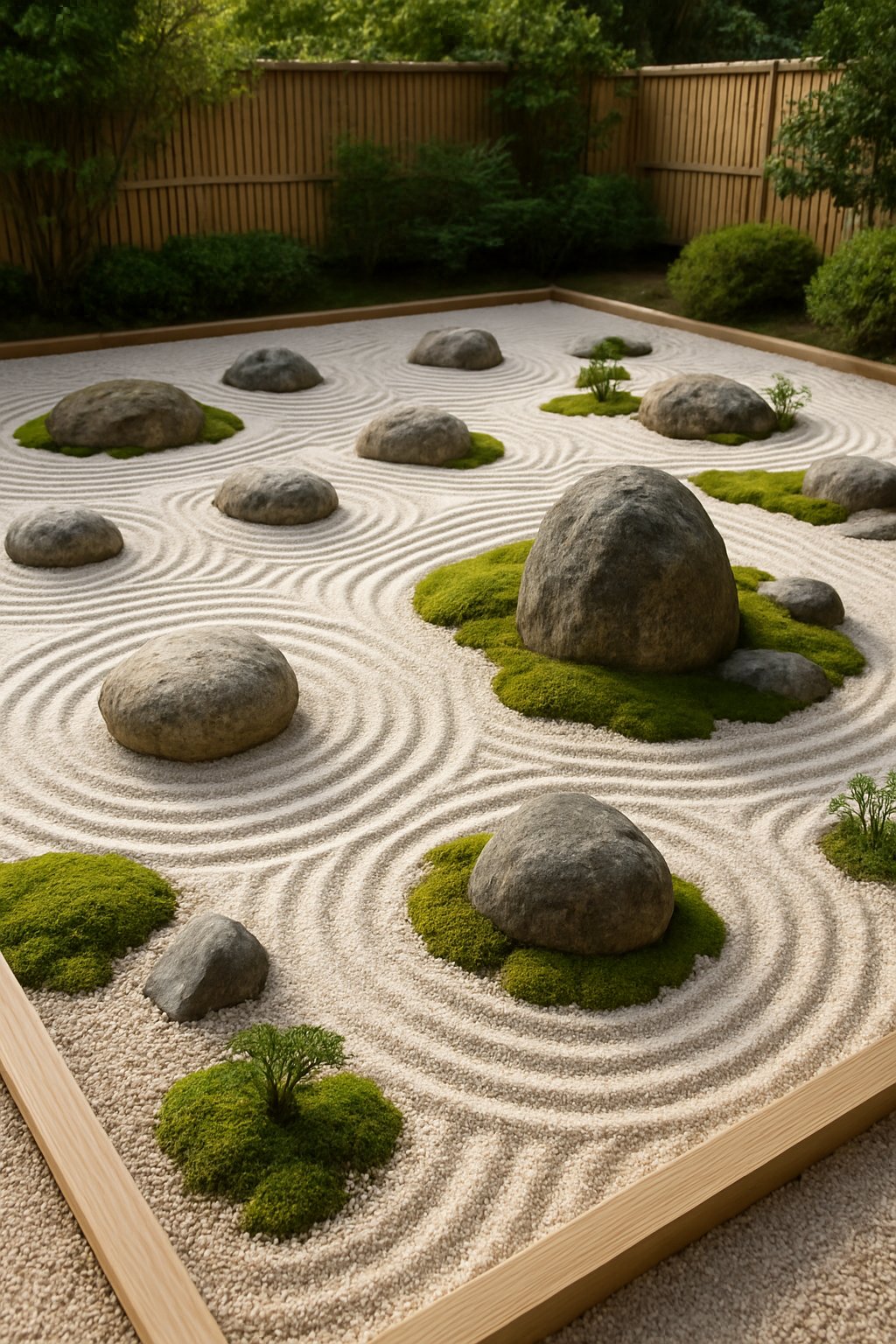
Turn a quiet corner into a Zen garden for a peaceful retreat. Spread sand or fine gravel for the base and rake flowing patterns for a meditative vibe.
Scatter stones of different sizes for balance. Place them thoughtfully so it feels natural but still purposeful. Skip the clutter—keep things simple and tidy.
Pick a spot that feels calm, maybe away from the busiest parts of your yard. You don’t need many plants—just a few low-maintenance ones if you want some greenery. A wooden bench or tiny bridge adds warmth and invites you to linger.
Zen gardens rarely need much upkeep and encourage you to slow down. If you’re after a peaceful corner without fuss, you’ll love this approach.
Expert Tip from MrPlanter: “Use a stiff rake to create clean, flowing patterns in the sand. Place stones in groups of odd numbers for a natural look.”
27. Create a butterfly-shaped flower bed design
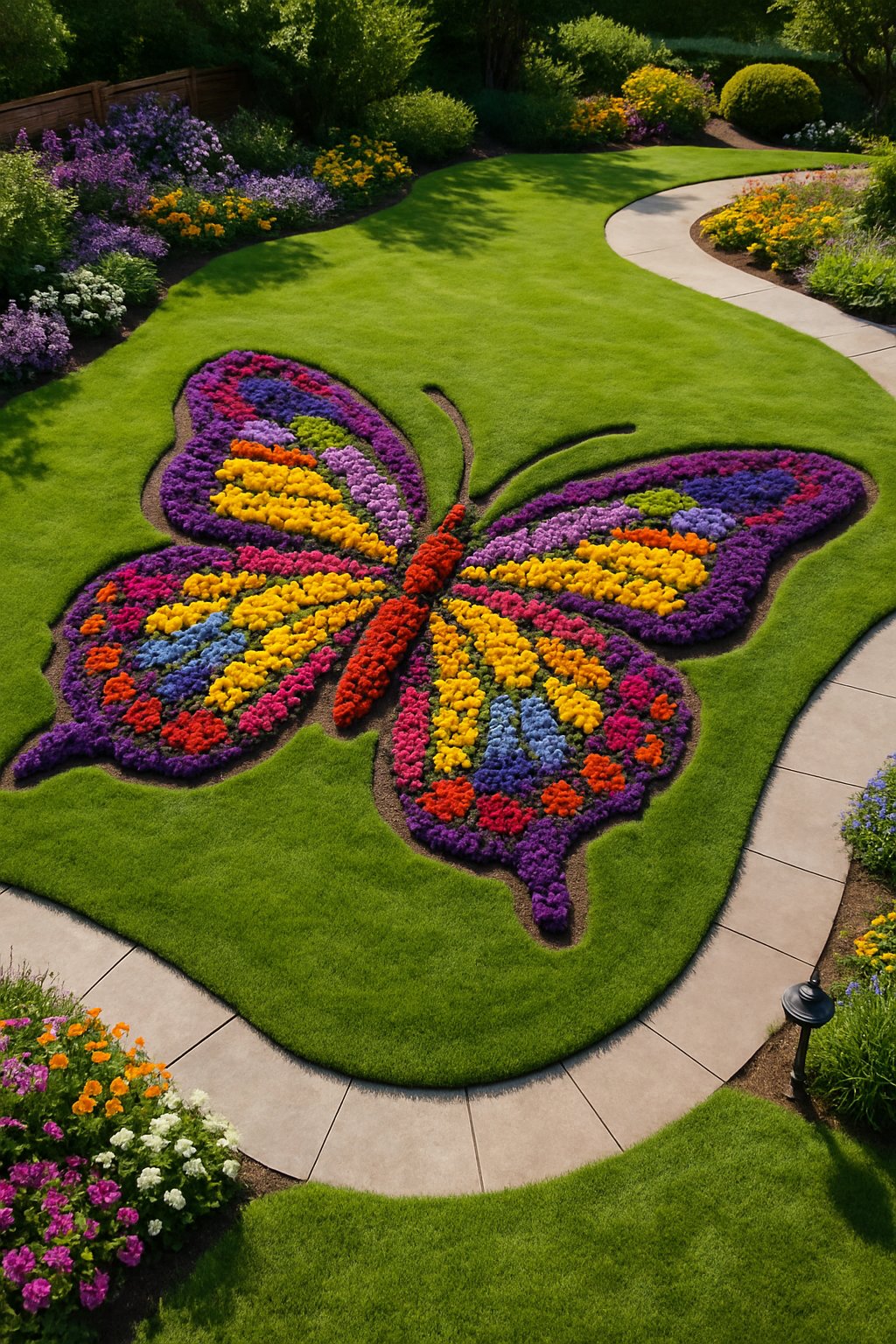
A butterfly-shaped flower bed brings a playful, eye-catching vibe to your landscape. Go for curved edges and use colorful flowers that echo butterfly wings.
I always pick bright bloomers like milkweed, lavender, or zinnias—they really draw in the butterflies. These plants don’t just look good; they’re magnets for pollinators.
Start by sketching out your plan on paper, or just mark the outline with some string right in the yard. Place your taller perennials in the center, then tuck in shorter annuals or groundcovers along the edges for that layered look.
Butterfly-friendly plants thrive in full sun, so pick a spot that gets lots of rays. If you want to see caterpillars munching away, add host plants like parsley or fennel right in the bed.
That way, you’ll support the whole butterfly life cycle, not just the pretty adults. Keep the soil loose and well-drained, and don’t forget to water when things get dry.
I like to lay a few stepping stones or a narrow path around the bed. It makes it easier to get close and check out all the action.
This kind of design doesn’t need a huge yard—it fits nicely in small or medium spaces. Honestly, it’s a fun way to show off your gardening chops and help out the pollinators at the same time.
Expert Tip from MrPlanter: “Choose native plants to help local butterfly species thrive. Plan your flower colors carefully to create a bold, eye-catching pattern.”
